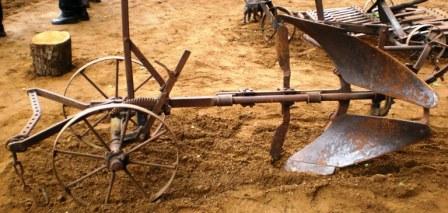To prepare a plot for sowing and planting it is digged or plowed. By this is the ground (for a while) weed free and has a loose structure. Digging or plowing you do basically only once, to start a garden. Furthermore, you better disturb the ground as little as possible.
Dig on one side of the plot a shovel (or spade) wide trench about 30 cm deep. Spoon adjacent an equally wide strip weed off, and place it upside down in the ditch (as fertilizer). Then twist the released ground below on fertilization in the ditch. In the newly created trench you repeat this again, until the plot is completed. Optionally, you can add additional fertilizer or compost in the ditch.
With only digging you can do 40 m2 per hour. If you then also should fertilize this bisects 15 to 20 m2 /h. Digging an hectare so costs 250 to 650 man-hours.
 Plowing works on the same principle. The spoon -shaped shell returns furrow by furrow each the ground. Sometimes there is (was) a little shell fore running that first turned the tares layer in the previous furrow. With a reversible plow you can at the end of the furrow turn the plow, and on the way back make a new next one. With a single furrow, the soil is always turned in the same direction. You begin then in the middle. All even furrows you do to the left of the first going on the way, all the odd furrows right on the way back.
Plowing works on the same principle. The spoon -shaped shell returns furrow by furrow each the ground. Sometimes there is (was) a little shell fore running that first turned the tares layer in the previous furrow. With a reversible plow you can at the end of the furrow turn the plow, and on the way back make a new next one. With a single furrow, the soil is always turned in the same direction. You begin then in the middle. All even furrows you do to the left of the first going on the way, all the odd furrows right on the way back.
After plowing (digging) usually follows the harrow (rake) to break the clods and crumble the ground.
In the 50s was plowed not deeper than 15 to 18 cm, so not deeper than the crumbly texture of the soil. Whether or not plow is a choice between two evils, depending on soil structure, load by heavy machinery, incorporation of green manure or manure.
If you dig organic matter too deep into dense soil, it is rotting. You can therefore better act superficial.
In ’A Farm for the Future” Rebecca Hosking suggests that to get one calorie on our plate 10 calories of oil (fuel) are consumed. We rape and destroy the soil and the soil life with lots of heavy machinery. And much too heavy cost. 1 or 2 hp should be sufficient. (hp, literally horsepower.)
Try to hold the soil covered and hold vegetation to keep the earth and biomass alive. Especially in the winter. This creates a fertile and living soil, that gives the plants much lead and less fertilizer is needed.
An ard
An ard consisted of a pole: a tree or stem that was pulled by oxen, on whitch cross a heel (plowshare or scissors) was attached to a tail or handle. The tip of the foot was hardened in the fire, and later sometimes covered with a bronze plaque.
This primitive slide plow was used until the Early Middle Ages. She’s also called scratch plow or chisel plow. The ard reverses the ground not, but only makes topsoil loose. It was cross- tossed in two directions. Maybe later the sole of this forerunner of the plow was tilted to return the land.
In terms of agriculture and technology China for centuries was centuries ahead to the West and the rest of the world. They had e.g. even rows of crops, hoes and even a good iron plow in the 6th century BC. When that knowledge finally reached Europe, the agricultural productivity went here forward with a leap. Their writings from the 14th century BC already prove the existence of the (wooden) plow. There are stone plow blades from 4 to 5,000 BC unearthed, and a bronze plow they had in the 16th century BC.
“Weed is a plant that mastered all survival techniques, but never learned how to grow in a neat row.”(Doug Larson)
